Why you can trust Tom's Hardware
Comparison Products
We put the Intel SSD 670p against a few of the best M.2 SSDs available, including one of its predecessors, the SSD 660p. For general PCIe Gen3 options, we added the Samsung 970 EVO Plus, Crucial P5, and Sabrent Rocket Q to the comparison pool. To represent potentially faster PCIe Gen4 SSDs, we included Adata's XPG Gammix S50 Lite, Silicon Power US70, and Samsung’s 980 Pro.
Game Scene Loading - Final Fantasy XIV
Final Fantasy XIV Shadowbringers is a free real-world game benchmark that easily and accurately compares game load times without the inaccuracy of using a stopwatch.
With an overall load time of 9.44 seconds, Intel’s SSD 670p starts off strong. The drive is only a hair slower than the Adata XPG Gammix S50 Lite and proves just as responsive to game storage-related requests as the best SSDs on the market.
Transfer Rates – DiskBench
We use the DiskBench storage benchmarking tool to test file transfer performance with a custom dataset. We copy a 50GB dataset including 31,227 files of various types, like pictures, PDFs, and videos to a new folder and then follow-up with a reading test of a newly-written 6.5GB zip file.


When it comes to large file transfers, the SSD 670p outperformed its predecessor by a significant margin and even outpaced the Crucial P5 and Rocket Q. However, when reading back those large files, it trailed the P5, Rocket Q, and the Adata XPG Gammix S50 Lite.
Trace Testing – PCMark 10 Storage Test
PCMark 10 is a trace-based benchmark that uses a wide-ranging set of real-world traces from popular applications and everyday tasks to measure the performance of storage devices. The quick benchmark is more relatable to those who use their PCs for leisure or basic office work, while the full benchmark relates more to power users.

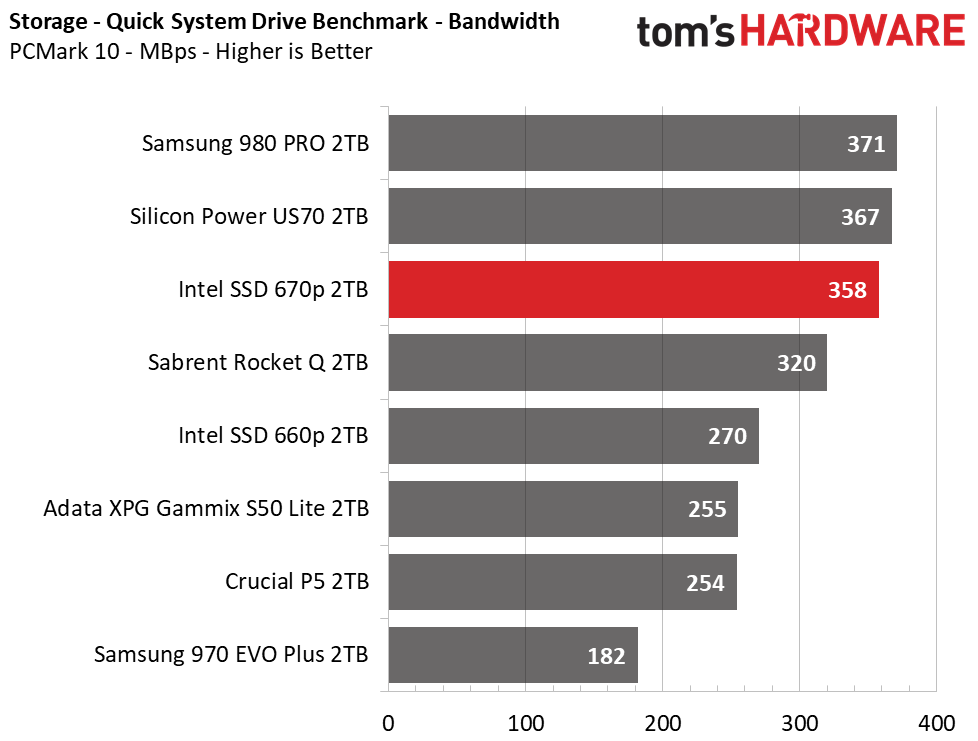




Intel says it focused heavily on improving mixed workload performance, and after seeing the results of our PCMark 10 and file copy tests, we can tell that effort has paid off. The SSD 670p took third place in the Quick System Drive benchmark. It also took a close second place to the Samsung 980 Pro in the Full System Drive benchmark.
Get Tom's Hardware's best news and in-depth reviews, straight to your inbox.
Synthetic Testing - ATTO / iometer
iometer is an advanced and highly configurable storage benchmarking tool while ATTO is a simple and free application that SSD vendors commonly use to assign sequential performance specifications to their products. Both of these tools give us insight into how the device handles different file sizes.
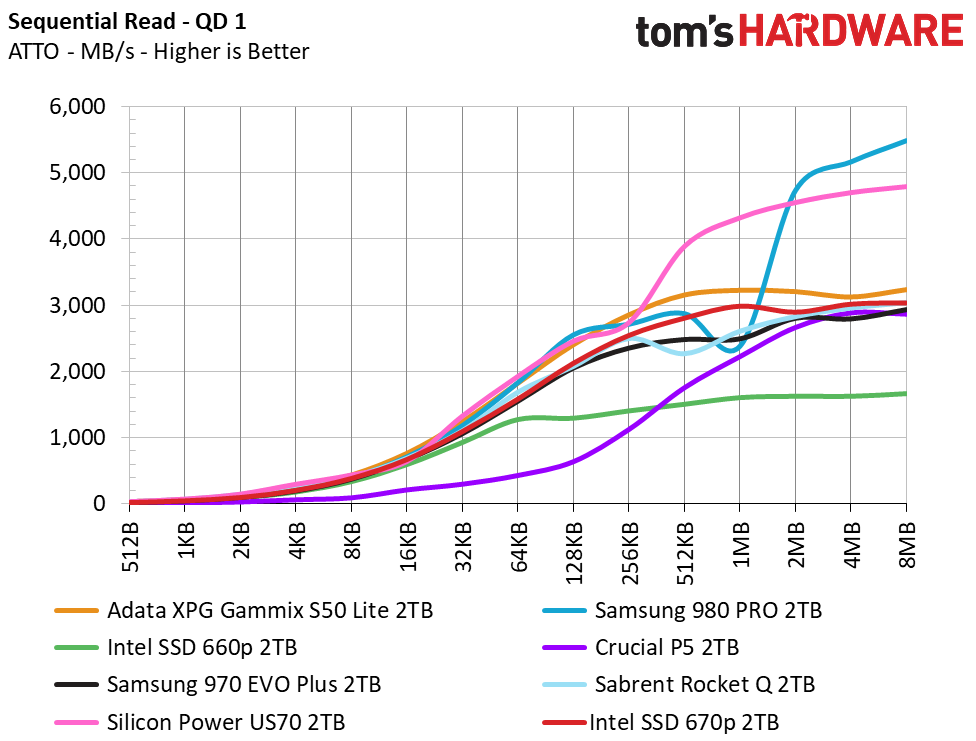






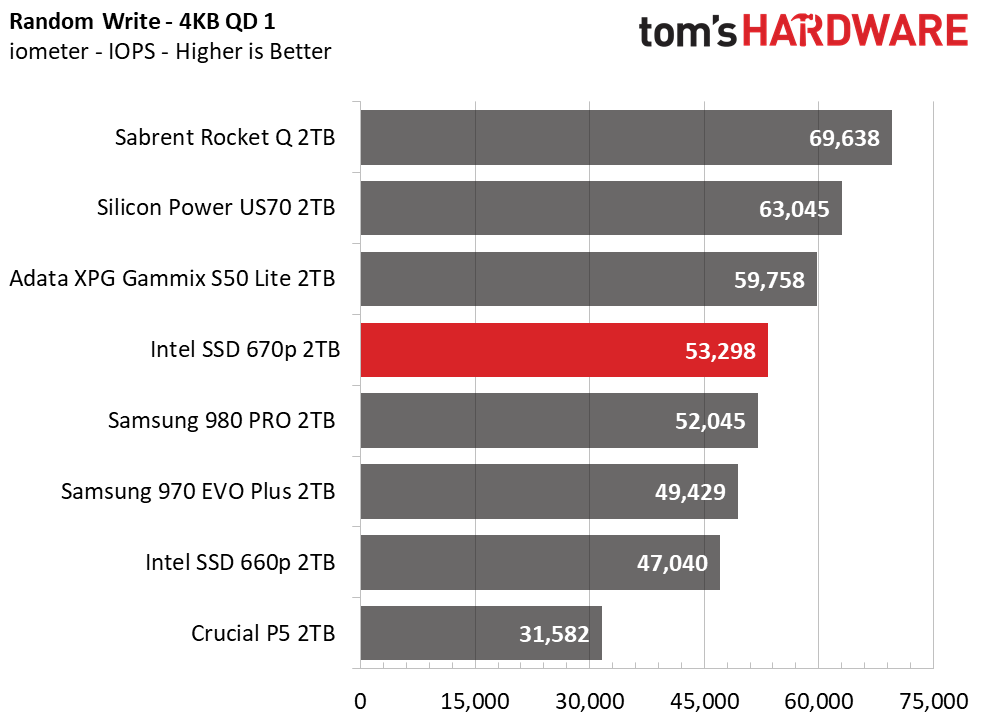


Intel’s SSD 670p delivers responsive sequential performance at a queue depth (QD) of 1. Still, the Adata XPG Gammix S50 Lite runs unshackled with the faster PCIe Gen4 interface, free to hit ever-so-slightly higher speeds. The Intel SSD 670p also tied Samsung’s 970 EVO in peak read performance and exceeded its own rated write speed.
In terms of random performance, Intel’s SSD 670p flaunts some of the most responsive results we have on record. Clocking in with read latency scores averaging just 0.05 ms, surpassing the Adata SSD, the Intel SSD 670p is the second-most responsive SSD in the group.
Intel tunes its SSDs specifically for performance at low queue depths, which can hinder maximum IOPS capability compared to other drives. Those peak numbers don’t matter much for consumers, though: Most desktop PC workloads reach QD 4-8 at most, more commonly landing in the QD 1-2 range.
Sustained Write Performance and Cache Recovery
Official write specifications are only part of the performance picture. Most SSDs implement a write cache, which is a fast area of (usually) pseudo-SLC programmed flash that absorbs incoming data. Sustained write speeds can suffer tremendously once the workload spills outside of the cache and into the "native" TLC or QLC flash. We use iometer to hammer the SSD with sequential writes for 15 minutes to measure both the size of the write cache and performance after the cache is saturated. We also monitor cache recovery via multiple idle rounds.
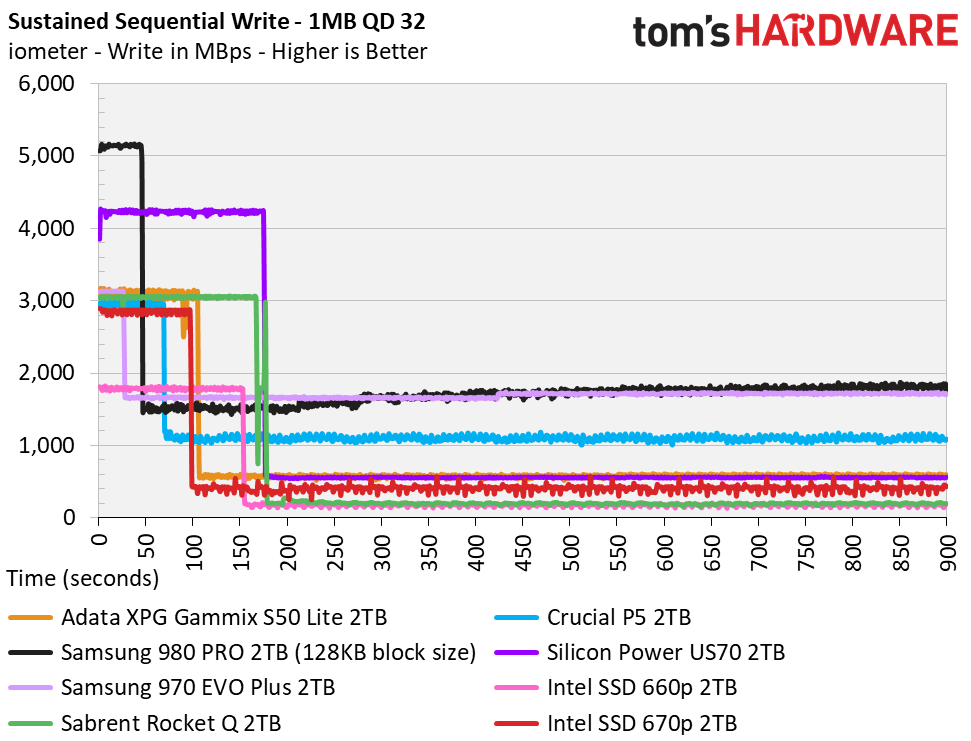




The Intel SSD 670p has the same SLC cache capacity as the 660p, but the new hardware allows it to absorb the same amount of data as its predecessor at much faster speeds. The 670p wrote at a rate of roughly 2,800 MBps until it had transferred 280GB of data. The SSD 670p’s sustained write speed degraded to an average of 400 MBps, which is more than twice the SSD 660p’s sustained write speed.
While Intel’s drive has improved significantly, it's nowhere near the capability of higher-end competitors. However, the SSD 670p’s dynamic SLC cache recovers rapidly, gaining back over 140GB of capacity with just a minute of idle time. The drive recovers fully within five minutes.
Power Consumption and Temperature
We use the Quarch HD Programmable Power Module to gain a deeper understanding of power characteristics. Idle power consumption is an important aspect to consider, especially if you're looking for a laptop upgrade. Some SSDs can consume watts of power at idle while better-suited ones sip just milliwatts. Average workload power consumption and max consumption are two other aspects of power consumption, but performance-per-watt is more important. A drive might consume more power during any given workload, but accomplishing a task faster allows the drive to drop into an idle state more quickly, ultimately saving energy.
We also monitor the drive’s temperature via the S.M.A.R.T. data and an IR thermometer to see when (or if) thermal throttling kicks in and how it impacts performance. Bear in mind that results will vary based on the workload and ambient air temperature.



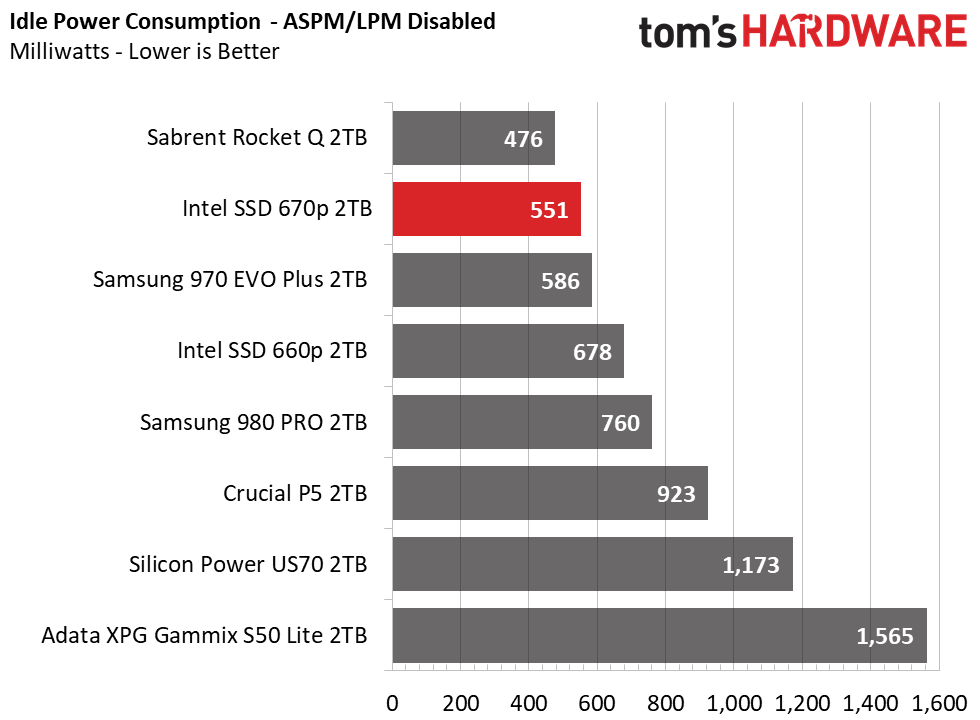
The 670p exchanges higher average power consumption for faster performance, but it still delivers a very respectable MBps-per-watt score that places it in between the Samsung 970 EVO Plus and Sabrent Rocket Q. The Adata Gammix S50 Lite is a bit more efficient under load, but when idle with ASPM is disabled, its power consumption is roughly three times that of the Intel drive. The 670p’s low power consumption leads to better thermals, and when we pushed the SSD 670p to sweat, it didn’t.
The Intel SSD 670p remained cool with components measuring in the low 30 degrees Celsius range at idle. The drive also didn’t throttle when we pressed it with a sustained 400GB of writes. The Intel SSD 670p reported a peak temperature of 70 degrees Celsius via its S.M.A.R.T. data, and we measured roughly 80 degrees Celsius at the controller with an infrared thermometer.
MORE: Best SSDs
MORE: How We Test HDDs And SSDs
MORE: All SSD Content

Sean is a Contributing Editor at Tom’s Hardware US, covering storage hardware.
-
mdd1963 In light of the Z590 being pretty darn imminent, you'd think Intel would have been releasing a PCI-e 4.0 drive about now....(vice merely catching up with the performance numbers of Samsung's 5 year old 950 Pro....)Reply -
RyzenNoob Not even faster than my ADATA drive, so hardly going to feature in possible upgrades in the futureReply -
anonymousdude The good is that it's improved QLC which is cool for entry level NVMe drives. The bad is that pricing that decidedly makes it not entry level. It costs more than the best PCI-e 3.0 drives and is QLC. There's no reason to get this drive when you can get for less. We'll have to let the dust settle and see where the actual market price ends up at. If it gets close to 660p pricing then it might be worth some consideration.Reply -
g-unit1111 I've bought several 660P drives, the price / performance ratio is usually one of the better ones in this segment. I would buy this one if the price drops to 660P levels.Reply -
Glock24 Has there ever been a QLC drive priced decently? I've never seen one. Even if there was I would not risk it.Reply -
USAFRet Reply
I got my 1TB 660p for $88, 18 months ago.Glock24 said:Has there ever been a QLC drive priced decently? I've never seen one. Even if there was I would not risk it.
So yes, there are. -
cyrusfox Reply
I picked up the 665p 1tb for $90 3 months back as well.Glock24 said:Has there ever been a QLC drive priced decently? I've never seen one. Even if there was I would not risk it.
Also second hand market from all the people upgrading their laptop and selling these, should be great.
Intel SSDs are quite ubiquitous. For instance my Ryzen 4700U HP laptop came with both an intel SSD 660p, as well as a wifi card AX200.
I think OEM will likely be 99% of the market for this drive. Glad Intel achieved more performance and endurance with the new controller. Also happy to see further innovation on the QLC front. REeally wonder who is going to achieve PLC first now.

